Home>Furniture & Design>Outdoor Furniture>How To Keep Outdoor Animals Cool In Summer


Outdoor Furniture
How To Keep Outdoor Animals Cool In Summer
Modified: October 19, 2024
Learn how to keep outdoor animals cool in the summer with the right furniture and design. Create a comfortable environment for your outdoor pets.
(Many of the links in this article redirect to a specific reviewed product. Your purchase of these products through affiliate links helps to generate commission for Storables.com, at no extra cost. Learn more)
Introduction
As the summer sun blazes down, it's not just humans who feel the heat – outdoor animals, from beloved pets to backyard wildlife, also face the sweltering temperatures. It's essential for pet owners and wildlife enthusiasts alike to understand the risks that high temperatures pose to these creatures and take proactive steps to keep them cool and comfortable.
In this comprehensive guide, we'll explore the various strategies and considerations for ensuring the well-being of outdoor animals during the hot summer months. From providing shade and shelter to creating cooling stations, we'll delve into practical and effective methods to help our furry and feathered friends beat the heat. Let's embark on this journey to safeguard the welfare of outdoor animals and create a cooler, more comfortable environment for them to thrive in.
Key Takeaways:
- Keep outdoor animals cool by providing shade, water, and cooling stations. This helps them stay healthy and comfortable during the hot summer months.
- Monitor outdoor animals closely during extreme heat and make adjustments to their routines and environments to minimize the risks associated with high temperatures.
Read more: How To Keep Outdoor Rabbits Cool In Summer
Understanding the Risks of Heat for Outdoor Animals
When the mercury rises, outdoor animals face a myriad of challenges that can jeopardize their health and well-being. Unlike humans, many animals are unable to regulate their body temperature as effectively, making them particularly vulnerable to heat-related illnesses. Dogs, cats, birds, and wildlife such as squirrels and rabbits are all susceptible to the dangers of extreme heat.
Heat exhaustion and heatstroke are among the most pressing concerns for outdoor animals during hot weather. These conditions can lead to symptoms such as excessive panting, lethargy, drooling, and in severe cases, loss of consciousness and organ failure. Additionally, hot pavement and surfaces can cause burns to animals’ paw pads, exacerbating their discomfort and risking injury.
It’s crucial to recognize the signs of heat stress in animals and take proactive measures to prevent these conditions from occurring. By understanding the specific risks posed by high temperatures, pet owners and wildlife enthusiasts can implement targeted strategies to mitigate the impact of the summer heat on their outdoor companions.
Furthermore, it’s important to consider the impact of heat on wildlife and birds. Natural water sources may dry up, and food may become scarce during prolonged heatwaves, placing additional strain on these creatures. By acknowledging these challenges, we can adopt a more holistic approach to supporting outdoor animals through the hottest months of the year.
Providing Shade and Shelter
Creating adequate shade and shelter is a fundamental aspect of safeguarding outdoor animals from the scorching summer sun. For pets such as dogs and cats, ensuring that shaded areas are readily accessible in the yard is essential. This can be achieved through the strategic placement of umbrellas, canopies, or purpose-built shade structures. Additionally, natural shade provided by trees or shrubbery can offer a cool retreat for animals seeking relief from the heat.
When considering the design of outdoor living spaces, it’s beneficial to incorporate shaded areas that cater to the needs of pets. This may involve integrating covered patios or designated shady spots where animals can rest comfortably without being exposed to direct sunlight. Furthermore, providing access to well-ventilated outdoor shelters, such as doghouses or insulated enclosures, offers animals a cool refuge from the heat.
Wildlife also benefit from the provision of shade and shelter. Birdhouses, nesting boxes, and squirrel feeders can be strategically placed in shaded areas to offer respite from the sun’s intense rays. Additionally, creating natural habitat features such as brush piles and rock formations provides wildlife with cool, sheltered spaces to escape the heat.
By prioritizing the availability of shade and shelter for outdoor animals, we can mitigate the risks associated with prolonged sun exposure and create a more comfortable environment for them to thrive in. This proactive approach contributes to the overall well-being of pets and wildlife during the sweltering summer months.
Ensuring Access to Cool Water
Hydration is paramount for outdoor animals during the hot summer months, making access to cool, clean water a top priority. For pets, it’s essential to provide multiple water sources in different areas of the outdoor space. This ensures that animals have easy access to hydration, even if they are moving between shaded and sunny areas. Additionally, using elevated or tip-proof water bowls can prevent spills and help maintain a fresh supply of water throughout the day.
Regularly refreshing water bowls and ensuring that the water remains cool is crucial for preventing dehydration and heat-related illnesses in pets. Adding ice cubes to water bowls or using specially designed cooling bowls can help lower the temperature of the water, providing a refreshing drink for animals seeking relief from the heat.
Wildlife also rely on accessible water sources to stay hydrated and cool. Bird baths, shallow dishes, or small ponds can attract a variety of wildlife, offering them a place to drink and bathe. During periods of extreme heat, replenishing these water sources frequently is essential to ensure that wildlife have a reliable reservoir to quench their thirst.
Furthermore, incorporating water features into outdoor spaces, such as fountains or recirculating ponds, can create a soothing oasis for both pets and wildlife. These features not only provide a source of hydration but also contribute to the overall cooling effect of the environment, making them valuable additions to any outdoor area frequented by animals.
By prioritizing access to cool water for outdoor animals, we can help them stay hydrated and healthy, even in the midst of summer’s most intense heatwaves. This simple yet crucial measure plays a pivotal role in supporting the well-being of pets and wildlife throughout the warmer months.
Provide plenty of shade and access to fresh, cool water at all times. Consider using misters or fans to help lower the temperature in their outdoor space.
Creating Cooling Stations
Establishing dedicated cooling stations in outdoor spaces can significantly alleviate the impact of high temperatures on animals. For pets, these stations can take the form of cooling mats, elevated beds, or designated areas with cooling fans. Cooling mats, which are activated by pressure and do not require refrigeration, offer pets a cool surface to rest on, providing relief from the heat. Elevated beds allow for increased airflow, keeping pets comfortable and preventing them from lying on hot surfaces.
Additionally, utilizing cooling fans in outdoor areas frequented by pets can help circulate air and create a more comfortable environment. These fans are designed to be safe for outdoor use and can be strategically placed to provide a cooling breeze in shaded areas.
When it comes to wildlife, creating cooling stations involves providing resources that offer relief from the heat. This can include shallow dishes filled with water for birds and small mammals, as well as strategically placed rocks or ceramic tiles that retain coolness. These simple yet effective measures offer wildlife the opportunity to cool off and regulate their body temperature during hot weather.
Another innovative approach to creating cooling stations for wildlife involves installing misting systems or drip irrigation near natural habitats. These systems provide a gentle mist or drip of water, creating a microclimate that offers respite from the heat for wildlife in the vicinity.
By establishing cooling stations tailored to the needs of both pets and wildlife, we can proactively mitigate the challenges posed by high temperatures. These stations serve as dedicated retreats where animals can seek relief from the heat, fostering a more comfortable and supportive environment for them during the summer months.
Monitoring and Adjusting for Extreme Heat
During periods of extreme heat, diligent monitoring and proactive adjustments are essential to safeguard the well-being of outdoor animals. For pets, it’s crucial to closely observe their behavior and physical condition, particularly during the hottest parts of the day. Signs of distress, such as excessive panting, lethargy, or seeking out cool surfaces, should prompt immediate intervention to prevent heat-related complications.
Adjusting outdoor activities and exercise routines to avoid the peak heat hours can help prevent pets from overexerting themselves in intense temperatures. Early morning or late evening walks and play sessions are preferable, as these times typically offer cooler conditions and reduce the risk of heat stress for pets.
For wildlife, monitoring natural habitats and supplementing food and water sources during extreme heat events is crucial. Providing additional sources of nourishment, such as bird feeders and wildlife-friendly plants, can support animals that may struggle to find sustenance during periods of prolonged heat and drought.
Furthermore, creating shaded areas in proximity to natural habitats can offer wildlife a refuge from the blistering sun. This can be achieved through the strategic placement of temporary shade structures or the preservation of existing vegetation to provide cool, sheltered spaces for wildlife.
When extreme heat warnings are issued, it’s important to take preemptive measures to protect outdoor animals. This may involve adjusting daily routines, providing supplemental cooling resources, and ensuring that animals have access to ample shade and water throughout the day. By remaining vigilant and responsive to weather conditions, we can minimize the impact of extreme heat on the well-being of pets and wildlife.
Conclusion
As the summer heat envelops outdoor spaces, the well-being of animals becomes a paramount concern. By understanding the risks posed by high temperatures and implementing proactive measures, pet owners and wildlife enthusiasts can create a cooler and more comfortable environment for their outdoor companions.
Providing ample shade and shelter is a foundational step in safeguarding animals from the heat. Strategic placement of shade structures and natural vegetation offers pets and wildlife respite from the sun’s intense rays, contributing to their overall comfort and well-being.
Access to cool, clean water is essential for hydration and heat relief. By ensuring that pets and wildlife have ready access to water sources, we support their physiological needs and help them stay cool and healthy during the hottest months of the year.
Creating dedicated cooling stations further enhances the ability of animals to cope with high temperatures. From cooling mats and elevated beds for pets to misting systems and shallow water dishes for wildlife, these stations offer vital retreats where animals can seek relief from the heat.
During periods of extreme heat, monitoring animals closely and making necessary adjustments to their routines and environments is crucial. By staying attuned to their behavior and needs, we can minimize the risks associated with prolonged exposure to intense heat.
Ultimately, the well-being of outdoor animals during the summer months hinges on our proactive efforts to create a cooler, more supportive environment for them. By integrating these strategies and considerations into our approach to pet care and wildlife stewardship, we can ensure that our outdoor companions thrive even in the face of the summer sun’s relentless heat.
Frequently Asked Questions about How To Keep Outdoor Animals Cool In Summer
Was this page helpful?
At Storables.com, we guarantee accurate and reliable information. Our content, validated by Expert Board Contributors, is crafted following stringent Editorial Policies. We're committed to providing you with well-researched, expert-backed insights for all your informational needs.















0 thoughts on “How To Keep Outdoor Animals Cool In Summer”